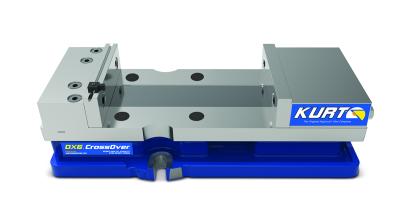
The Kurt DX6 Crossover vise design features are reportedly proven to help machinists enhance their ability to machine parts better and increase productivity. The DX6 vise mounts and locates directly onto 40mm, 50mm and 2” grid patterns. This provides for an accurate workholding setup and repeatable reference and elimination of relocating and reduces setup time.
DX6 vise also mounts through the body from the top-side of the vise expediting removal when necessary. Traditional vise mounting through side clamping ears is still a feature built-in to the vise. DX6 also accepts sine keys for alignment directly on the machine table, and mounts easily to an adjustable swivel base.
With a narrow vise body and footprint of 7.391” wide x 16.810” long, DX6 vise makes it possible to mount more vises on many machine tables. And with a full 9-inch opening within the inside jaw position, larger workpieces can be held over other vises styles. This larger holding capacity and higher density of vises helps cut tool change time and boost part output productivity.
The DX6 vise body is equipped with easy chip and coolant evacuation straight through the body at back of the vise and sides. This helps prevent chip buildup and makes it easier and reduces the time the machinist performs a blow-out of chips, which is commonly after each part removal.
Additional DX6 CrossOver vise also features 80,000-psi ductile iron body, nut and movable jaw, a semihard steel screw and a hardened vise bed and jaw plates. A GrooveLock jaw plate and workstop are included for convenient part positioning. Larger and stronger bearing pack adds to longer life. New brush seal design for easier removal or replacement in the nut.
Contact Details
Related Glossary Terms
- coolant
coolant
Fluid that reduces temperature buildup at the tool/workpiece interface during machining. Normally takes the form of a liquid such as soluble or chemical mixtures (semisynthetic, synthetic) but can be pressurized air or other gas. Because of water’s ability to absorb great quantities of heat, it is widely used as a coolant and vehicle for various cutting compounds, with the water-to-compound ratio varying with the machining task. See cutting fluid; semisynthetic cutting fluid; soluble-oil cutting fluid; synthetic cutting fluid.

